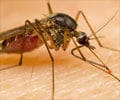A new genome-editing technique, called CRISPR, discovered by MIT biological engineers can disrupt a single malarial parasite gene with a success rate of up to 100 percent — in a matter of weeks.

The paper's lead author is Jeffrey Wagner, a recent PhD recipient and current MIT postdoc in biological engineering. Graduate student Randall Platt, recent PhD recipient Stephen Goldfless, and Feng Zhang, the W.M. Keck Career Development Assistant Professor in Biomedical Engineering, also contributed to the research.
Plasmodium falciparum, a blood-borne parasite carried by mosquitoes, is responsible for most of the estimated 219 million cases, and 655,000 deaths, from malaria per year. Treatments include chloroquine and artemisin, but the parasite is becoming more resistant to these drugs.
There is an urgent need to develop new drugs, but potential genetic targets are hard to identify. In animals such as mice, it is fairly routine to study gene functions by deleting a target gene or replacing it with an artificial piece of DNA. However, in Plasmodium falciparum, this approach can take up to a year because it relies on homologous recombination, a type of genetic swapping that cells use to repair broken DNA strands. This occurs very rarely in the genome of the malaria parasite.
"You have to rely on this really inefficient process that occurs only if you have spontaneous DNA strand breaks that happen to fall within your region of interest," Niles says.
Using this time-consuming approach, scientists have been able to identify functions for some of the genes necessary for the parasite to invade red blood cells, as well as some of the genes required for the parasite to later erupt from blood cells. More recently, researchers have successfully used enzymes called zinc finger nucleases to cut out specific genes, but this approach is costly because it requires a new nuclease to be designed for each gene target.
As soon as researchers successfully demonstrated that this system could work in cells other than bacteria, Niles started to think about using it to manipulate Plasmodium falciparum. To test this approach, he and his colleagues tried using CRISPR to disrupt two genes, kahrp and eba-175, that had previously been knocked out in malaria using traditional approaches.
With eba-175, which codes for a protein that binds to red blood cell receptors and helps the parasite get into the cells, the researchers disrupted this gene in 50 to 80 percent of parasites manipulated with the CRISPR system. "We consider this to be a win," Niles says. "Compared to the efficiency with which P. falciparum genetics have been done in the past, even 50 percent is pretty substantial."
For both targets, the researchers demonstrated that they could insert a gene for the protein luciferase, which emits light, in addition to turning off the existing genes.
Now that CRISPR technology has been validated in Plasmodium falciparum, Niles expects that many scientists will adopt it for genetic studies of the parasite. Such efforts could reveal more about how the parasite invades red blood cells and replicates inside cells, which could generate new drug and vaccine targets.
"I think the impact could be quite huge," Niles says. "It lowers the barrier to really being more imaginative in terms of how we do experiments and the kinds of questions that we can ask."
Source-Eurekalert
 MEDINDIA
MEDINDIA




 Email
Email







